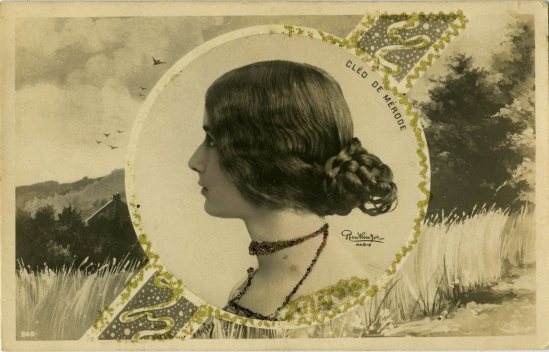
Cléo de Mérode by Reutlinger via


Cléo de Mérode by Reutlinger via
Nadar was the pseudonym of Gaspard-Félix Tournachon (1820 – 1910), a French photographer, caricaturist, journalist, novelist, and balloonist.
Nadar was born in April 1820 in Paris (though some sources state Lyon). He took his first photographs in 1853 and in 1858 became the first person to take aerial photographs. He also pioneered the use of artificial lighting in photography, working in the catacombs of Paris and later became the number one portrait photographer for the French elite. In April 1874, he lent his photo studio to a group of painters, thus making the first exhibition of the Impressionists possible. Nadar died in 1910, aged 89. He was buried in Père Lachaise Cemetery in Paris. Today, examples of Nadar’s photographic portraits are held by many of the great national collections of photographs.

Selika Lazevski was an écuyère who performed haute école – which means she was an equestrian who rode high school dressage in French circuses in the 19th century, by Félix Nadar, 1891 via

Polaire by Félix Nadar via
![French photographer Felix Nadar was the first to take aerial photographs and later became the number one portrait photographer for the French elite. [Sarah Bernard]](https://i0.wp.com/media-cache-ak0.pinimg.com/736x/09/c0/8a/09c08aae3b9460ecde31c775874027d8.jpg)
Sarah Bernardt by Félix Nadar via

Cléo de Mérode by Félix Nadar, c.1900 via

George Sand by Félix Nadar, 1864 via

Berthe Morisot by Felix Nadar, 1875 via
Dancer Cleo de Merode (1875 – 1966) became famous at a young age. Born in Bordeaux, France, she came from an aristocratic family. Her father was a member of the Belgian nobility and a landscape painter.
In 1896, King Léopold II attended the ballet and saw Mérode dance. The 61-year-old Belgian King became enamoured with the 22-year-old ballet star, and gossip started that she was his latest mistress. Because the King had had two children with a woman reputed to be a prostitute, Cléo de Mérode’s reputation suffered, and she had to live with it for the rest of her life. Nevertheless, Cléo de Mérode became an international star, performing across Europe and in the United States.
Mérode became renowned for her glamour even more than for her dancing skills, and her image began appearing on postcards and playing cards. A particular new hairstyle she chose at age 16 became the talk of Parisian women and was quickly adopted as a popular style – parted in the middle, pulled back over the ears and wound into a chignon at the back, often worn with metal band.
At the peak of her popularity, she chose to dance at the Folies Bergère, taking the risk to do something other elites of the ballet had never done before. Her performance gained her a whole new following. Her fame was such that Alexandre Falguière sculpted The Dancer in her image, which today can be seen in the Musée d’Orsay. In 1895, Henri de Toulouse-Lautrec did her portrait, as would Charles Puyo, Alfredo Muller, and Giovanni Boldini.
Mérode continued to dance until her early fifties, when she retired to the seaside resort of Biarritz in the Pyrénées-Atlantiques département of France. In 1955, she published her autobiography, Le Ballet de ma vie (The Dance of My Life).
She died in 1966 and was interred in the Père Lachaise Cemetery in Paris in Division 90. A statue of her, mourning her mother, who is interred in the same plot, decorates the gravestone.

Carte postale, (envoyée en 1901), illustrée d’une photographie de Cléo de Mérode en costume de scène via
![]()
Studio NPG, Portrait of Cleo de Merode, 1903 via
![]()
Cléo de Mérode by Leopold Reutlinger, 1900 via
![]()
Cléo de Mérode by Reutlinger via
![]()
Cléo de Mérode via
![]()
Cléo de Merode by Charles Ogerau, 1893 via

Cléo de Mérode via
![]()
Cléo de Mérode, 1910 via